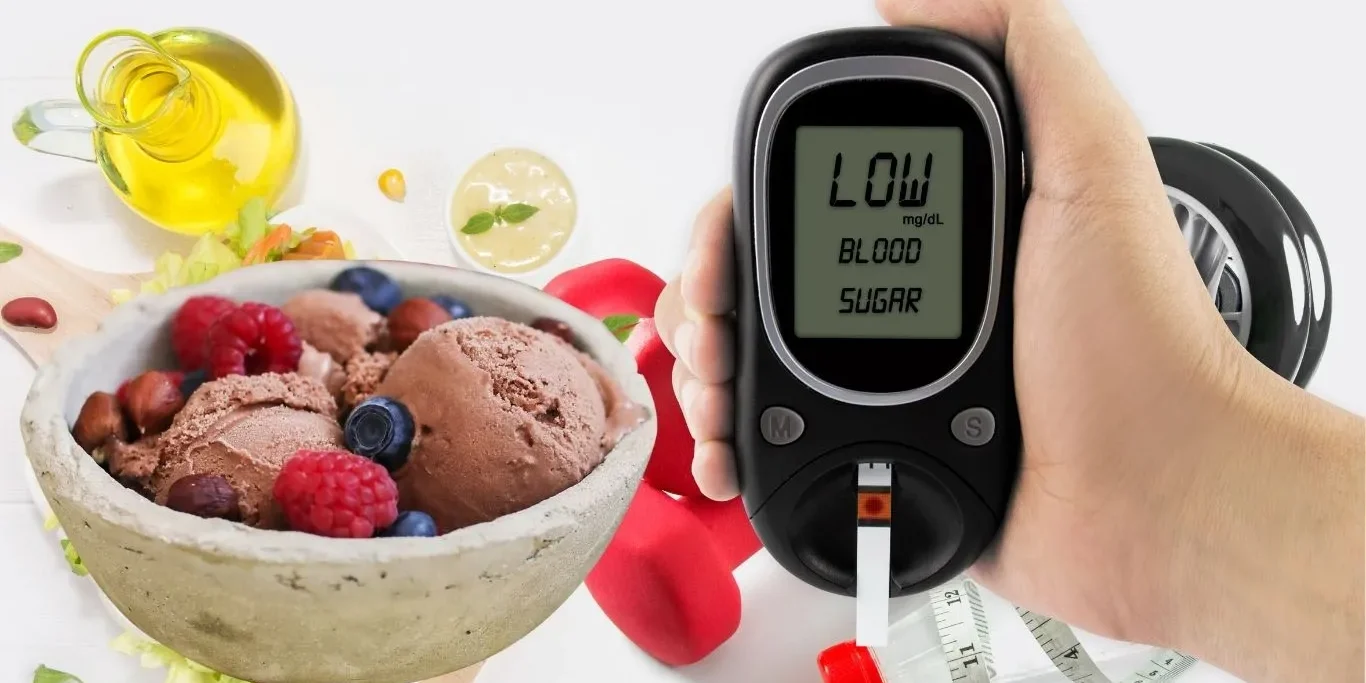If you have diabetes, then dessert can feel like forbidden territory. In particular, ice cream frequently tops the list of foods to avoid due to its high sugar and carbohydrate content. The good news is that people with diabetes can enjoy ice cream; they just need to know what to look for and how to make better choices. Today, more options of Ice Cream for Diabetics make it possible to satisfy a sweet tooth without sacrificing blood sugar control
Many people with diabetes crave the same sweet, creamy comfort of ice cream that everyone else does. The hard part is keeping blood sugar levels stable without missing out on something. Thanks to advances in food science, there are plenty of options like sugar-free ice cream for diabetics, low-sugar ice cream varieties, and even mainstream brands such as Blue Bunny creating diabetic-friendly alternatives.
This guide will discuss everything you need to know about picking the best ice cream for people with diabetes, enjoying it without feeling bad, and making it a part of a healthy lifestyle.
Can Diabetics Eat Ice Cream?
The short answer: yes, but with care. Ice cream is not automatically restricted for people with diabetes. They can still eat ice cream. What’s really important is:
- Portion size – Eating a little scoop instead of a whole bowl can make a big difference.
- Carbohydrate content – Checking labels for total carbs is vital because it directly affects blood sugar.
- Added sugars – Sugar-free or low-sugar ice cream for people with diabetes can be a better option than traditional ice cream. Because traditional ice creams often contain a lot of refined sugar.
Instead of thinking of ice cream as “bad,” viewing it as an occasional treat can be managed wisely within your eating plan.
What Makes the Best Ice Cream for Diabetics?
The following factors should be taken into account when purchasing ice cream:
- Low or no added sugar – Look for sweeteners that aren’t sugar, like monk fruit, stevia, or allulose.
- High fiber: Fiber helps control blood sugar levels by slowing down the absorption of sugar.
- Lower fat content – While fat doesn’t directly raise blood sugar, high-fat desserts can add extra calories.
- Packaging that is easy to share – Mini cups or bars help you not overeat.
A good rule of thumb: keep your serving under 15–20 grams of carbs when possible.
Popular Options: Sugar Free and Low Sugar Ice Cream
These days, the freezer aisle has plenty of diabetic-friendly choices. Some well-known options include:
- Blue Bunny Ice Cream for Diabetics (Sweet Freedom line) – A long-standing favorite offering reduced sugar and fewer carbs.
- Halo Top – A low-calorie, high-protein ice cream with many sugar free or low sugar flavors.
- Enlightened – Well-known for having a high fiber and low net carbohydrate content, making it appropriate for blood sugar management.
- Breyers Carb Smart – A lower-carb version of classic Breyers ice cream.
If you’re unsure, always check the nutrition label—sometimes “sugar free” doesn’t mean “carb free.”
Homemade Ice Cream for Diabetics
If store-bought isn’t appealing, making ice cream at home is easier than you think. This way, you control the ingredients. Some ideas are as follows:
- Banana Nice Cream– Add a splash of unsweetened almond milk to frozen bananas and blend them. Add cinnamon or cocoa for flavor.
- Greek Yogurt Ice Cream– Mix Greek yogurt and berries with a natural sugar substitute, then freeze.
- Avocado Ice Cream– Blend avocado, unsweetened cocoa powder, and stevia to make a chocolatey, creamy treat.
These alternatives are tasty, provide more nutrients, and fiber.
How to Eat Ice Cream Without Raising Blood Sugar
- Pair it with protein or fiber – Eating ice cream after a protein-rich meal (like grilled chicken or beans) helps reduce spikes.
- Watch your portion size – Stick to half a cup or a single bar.
- Eat slowly – Enjoying each slow bite helps with satisfaction and reduces cravings.
- Pick toppings carefully – Instead of using candy or sweet syrups, use fresh berries, almonds, or cinnamon.
- Maintain an activity balance – Your body can use glucose more effectively if you take a short walk after dessert.
Common Myths About Ice Cream and Diabetes
- Myth 1: Diabetics can never consume ice cream.
Reality:Ice cream can be included in a balanced diet when consumed in moderation and with the proper selection. - Myth 2: Sugar-free ice cream is always safe.
Reality: Some sugar substitutes can still raise blood sugar a little, and the amount of carbs still matters. - Myth 3: Just “diet” ice cream is acceptable.
Reality: A small scoop of regular ice cream is sometimes better than overeating the sugar free ice cream.
How to Choose the Right Ice Cream at the Store
When browsing the freezer aisle, here’s what to check on the label:
- Total carbohydrates – Aim for under 20 grams per serving.
- Added sugars – Look for only 5 grams or less.
- Fiber content – More fiber improves blood sugar regulation
- Serving size – Compare the nutritional value according to how much you will actually eat.
If you see “Blue Bunny ice cream for diabetics” or “low sugar ice cream for diabetics” on the label, it’s a sign the brand designed it with you in mind.
Can Ice Cream Be Part of a Diabetes-Friendly Diet?
Yes! Ice cream doesn’t have to be banned—it just has to fit into your overall eating plan. Here’s how:
- Plan ahead: Balance your carb intake at other meals if you know you’ll have dessert.
- Keep healthier options at home: Stock homemade alternatives or sugar free ice cream for people with diabetes.
- Engage in mindful eating: Concentrating on taste and contentment rather than guilt.
By making intentional choices, you can enjoy ice cream without derailing your health goals.
Final Thoughts about Ice Cream for Diabetics
Living with diabetes doesn’t mean that you have to give up your favorite treats. Ice cream for diabetics is also possible and enjoyable when chosen wisely. From sugar free ice cream for people with diabetes to homemade low sugar recipes, many options are available to satisfy your sweet tooth while keeping blood sugar in check.
The main things are moderation, label-checking, and pairing ice cream with a balanced lifestyle. So, don’t shy away from exploring diabetic-friendly brands like Blue Bunny, Halo Top, or Enlightened—or even trying your hand at homemade recipes.
If you have diabetes, your life is about finding balance, not hardship. That balance can include ice cream, too.
Frequently Asked Questions (FAQs)
Can people with diabetes eat ice cream?
Yes, the person who has diabetes can eat ice cream in moderation. The key is to monitor the sizes of the portions, check the carbohydrate and sugar content, and select sugar free or low sugar ice cream whenever possible.
What is the best ice cream for diabetics?
The best ice cream for diabetics is that which has little to no added sugar, higher fiber, and fewer net carbs. Popular options are Blue Bunny Sweet Freedom, Breyers Carb Smart, Enlightened, and Halo Top.
Is sugar-free ice cream always safe for diabetics?
Not always. Although sugar free ice cream doesn’t have added sugar, it may still contain carbohydrates that impact blood sugar levels. Checking the nutrition label is essential because some sugar substitutes may slightly increase blood glucose levels.
Are there homemade ice cream options for diabetics?
Absolutely! Easy recipes like avocado cocoa ice cream, Greek yoghurt ice cream, and banana ice cream are tasty, nutritious, and help you manage ingredients for better blood sugar control.
How can I enjoy ice cream without raising blood sugar?
Choose healthier toppings like berries or nuts, eat slowly, keep portions small, and pair ice cream with fibre or protein. After dessert, a short walk can also help your body use glucose more efficiently.
Can ice cream be part of a diabetes-friendly diet?
Yes. Ice cream can be included in a balanced diet for people with diabetes as an occasional treat. The trick is planning, choosing innovative options, and practicing mindful eating.
👉 Discover the top fruits good for kidneys to support overall health while managing your diet.





